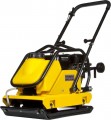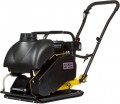Impact force
The force of each impact provided by the vibrating plate during operation. The intensity of the impact directly depends on this indicator, and, consequently, the density and thickness of the material that the vibrating plate can effectively compact. At the same time, in some cases (for example, when working with paving slabs), a high impact force may be undesirable. Recommendations on the optimal value of this indicator for different cases can be found in special sources.
Vibration frequency
The frequency of movements made by the sole of the tool in normal operation. For different materials, the optimal vibration frequency may also be different; specific recommendations can be found in special sources. It should be noted that classical vibrating plates (see "Type") have a rather high frequency of operation — from 3700 beats / min and above, but in vibrating rammers this figure is much lower and rarely exceeds 700 beats / min; such differences are due to differences in the way they work.
Sole length
The length of the sole — the working surface of the sole. The sole area depends on the length and width (see below) — that is, the space captured by the vibrating plate without moving from its place. Larger soles are comfortable for large volumes of work in wide spaces, while more compact ones perform better in tight spaces and apply more pressure (all other things being equal).
Sole width
The width of the working surface of the vibrating plate. The area of the sole depends on the length and width, respectively, its suitability for processing large spaces. Specifically, the width determines, on the one hand, the size of the strip captured in one pass, on the other hand, the passability of the unit. So, for open spaces, wide soles will be convenient, they will allow you to cope with the processing in fewer passes; but when working in narrow places, the width should be small, otherwise the vibrating plate may simply not fit in the right place.
Speed
The speed of the vibrating plate in normal operation. This parameter, along with the size of the sole, determines the performance of the unit. High speed allows you to quickly cope with a vast amount of work, however, it requires the appropriate engine power, which affects the "gluttony" and the price of the vibrating plate.
Fuel consumption
Nominal fuel consumption of a vibrating plate with an internal combustion engine (see "Engine type"). This parameter allows you to estimate how much fuel is required for certain jobs (taking into account the speed of movement, see above). In addition, knowing the volume of the fuel tank (see above), fuel consumption can be used to calculate the operating time at a gas station. Note that powerful performant engines inevitably have a rather high consumption.
Weight
The total weight of the vibrating plate. For models with internal combustion engines (see "Engine type") it is indicated without taking into account the fuel in the tank; however, the weight of the fuel compared to the weight of the unit itself is usually very small, and this difference can be neglected.
Weight directly affects the impact force that the unit can provide, and, as a result, the purpose and use of the tool. So, in the case of classic vibrating plates (see "Type"), an indicator of up to 75 kg corresponds to light weight, such a tool is designed mainly for loose materials (sand, soil, fine gravel) and a small compaction depth (up to 15 cm). An indicator of 75 – 90 kg allows you to achieve a depth of up to 25 cm, such models can already be used not only in landscape work, but also when laying asphalt. A weight of 90 – 140 kg corresponds to the average level, the purpose of most of these models is road work and general construction. Professional equipment has a weight of 150 kg, it can be used for almost any material and even used as a replacement for road rollers, however, and costs accordingly.
In turn, the weight of vibratory rammers is usually in the range of 60 – 90 kg, and vibrating screeds weigh even less — usually less than 25 kg.

